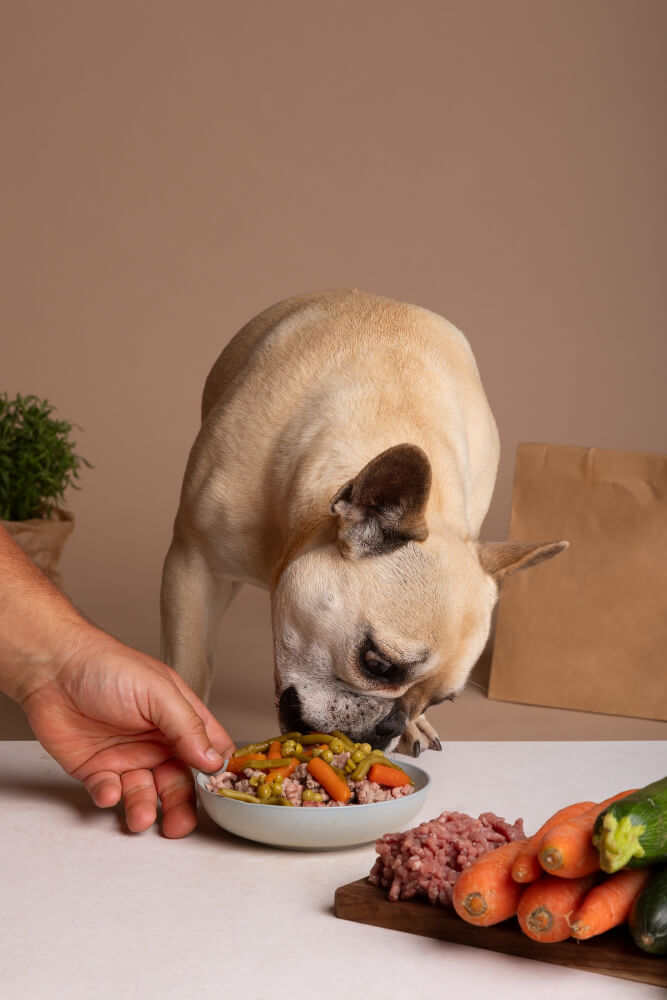As dog owners, we want the best for our furry friends. While commercial dog food is convenient, many pet parents are turning to home cooking for their dogs to ensure their meals are wholesome, fresh, and tailored to their specific needs. Cooking for your dog can be a rewarding way to bond and promote better health—but it’s important to get it right.
In this article, we’ll explore the benefits of home cooked meals for dogs, share essential tips, and provide simple, balanced recipes your pup will love.

Why Consider Home Cooking for Your Dog?
Home cooking gives you complete control over your dog’s diet, allowing you to prioritize quality and customization. Here’s why many pet owners make the switch:
Control Over Ingredients
You know exactly what’s going into your dog’s bowl—no hidden fillers, preservatives, or artificial additives.
Tailored Nutrition
Whether your dog has allergies, sensitivities, or specific health needs, home-cooked meals can be customized to meet their dietary requirements.
Freshness and Quality
Using fresh, high-quality ingredients ensures your dog gets the best nutrients without unnecessary processing.
Improved Palatability
Home-cooked meals are often more flavorful than kibble, making them an excellent choice for picky eaters.
The Basics of Home Cooking for Dogs
Before you grab your apron, there are a few important guidelines to follow when preparing meals for your dog.
Key Nutrients to Include
A well-balanced diet is crucial for your dog’s health. Make sure to include the following:
- Protein: The main ingredient in any dog’s diet. Good sources include chicken, turkey, beef, fish, and eggs.
- Carbohydrates: Provide energy. Options like rice, quinoa, sweet potatoes, and oats are dog-friendly.
- Fats: Essential for skin, coat, and overall health. Use healthy fats like fish oil or coconut oil.
- Vegetables: Add vitamins and fiber. Safe options include carrots, green beans, spinach, and zucchini.
- Calcium and Phosphorus: Crucial for bone health. Incorporate sources like ground eggshells or a calcium supplement.
Foods to Avoid
Not all human foods are safe for dogs. Keep these off the menu:
- Chocolate
- Onions and garlic
- Grapes and raisins
- Avocado
- Macadamia nuts
- Spices like nutmeg or excessive salt
Portion Control
Your dog’s portion size depends on their size, age, activity level, and overall health. Consult your vet to determine the right calorie intake and serving size for your pet.
Simple Recipes for Home-Cooked Dog Meals
Here are three easy recipes that provide balanced nutrition and plenty of tail wags.
Chicken and Rice Delight
Ingredients:
- 2 cups cooked chicken breast (shredded)
- 1 cup cooked brown rice
- 1/2 cup steamed carrots (diced)
- 1/2 cup steamed green beans
Instructions:
- Mix all ingredients in a large bowl.
- Allow to cool before serving.
- Store leftovers in the refrigerator for up to three days.
Turkey and Sweet Potato Mash
Ingredients:
- 2 cups ground turkey
- 1 cup mashed sweet potatoes
- 1/2 cup cooked spinach (chopped)
- 1 tsp fish oil
Instructions:
- Cook the ground turkey thoroughly in a skillet.
- Combine with mashed sweet potatoes and spinach.
- Drizzle with fish oil before serving.
Salmon and Veggie Medley
Ingredients:
- 1 cup cooked salmon (bones removed)
- 1/2 cup quinoa (cooked)
- 1/2 cup steamed zucchini (diced)
- 1/4 cup blueberries
Instructions:
- Flake the salmon into small pieces.
- Mix with cooked quinoa, zucchini, and blueberries.
- Serve once cooled.

Consult Your Veterinarian
Before transitioning to home-cooked meals, consult your vet or a pet nutritionist to ensure your dog’s diet is balanced. They may recommend supplements, such as:
- Calcium: For bone health.
- Fish Oil: For omega-3 fatty acids.
- Multivitamins: To fill any nutritional gaps.
Tips for Successful Home Cooking
- Batch Cooking: Prepare meals in bulk and freeze portions for convenience.
- Consistency: Stick to a regular feeding schedule to maintain your dog’s digestion.
- Observe and Adjust: Monitor your dog’s weight, energy levels, and coat condition, and make adjustments as needed.
When to Stick with Commercial Dog Food
While home cooking has many benefits, it’s not always the best option for every dog owner.
- Time Constraints: Preparing meals can be time-consuming.
- Cost: Fresh, high-quality ingredients can add up.
- Specific Health Issues: Dogs with certain medical conditions may require specialized commercial diets prescribed by a vet.
If home cooking isn’t feasible, you can still enhance your dog’s meals with healthy toppers like cooked chicken or steamed veggies.
Final Thoughts on Home Cooking for Dogs
Cooking for your dog can be a fulfilling way to show love and care. With proper planning, you can provide them with fresh, nutritious meals that cater to their specific needs. Whether it’s a chicken and rice bowl or a salmon medley, your dog will appreciate the effort—and the tasty results!
Are you ready to get started? Share your home-cooking adventures in the comments below, and let us know if you have a favorite recipe for your pup.







